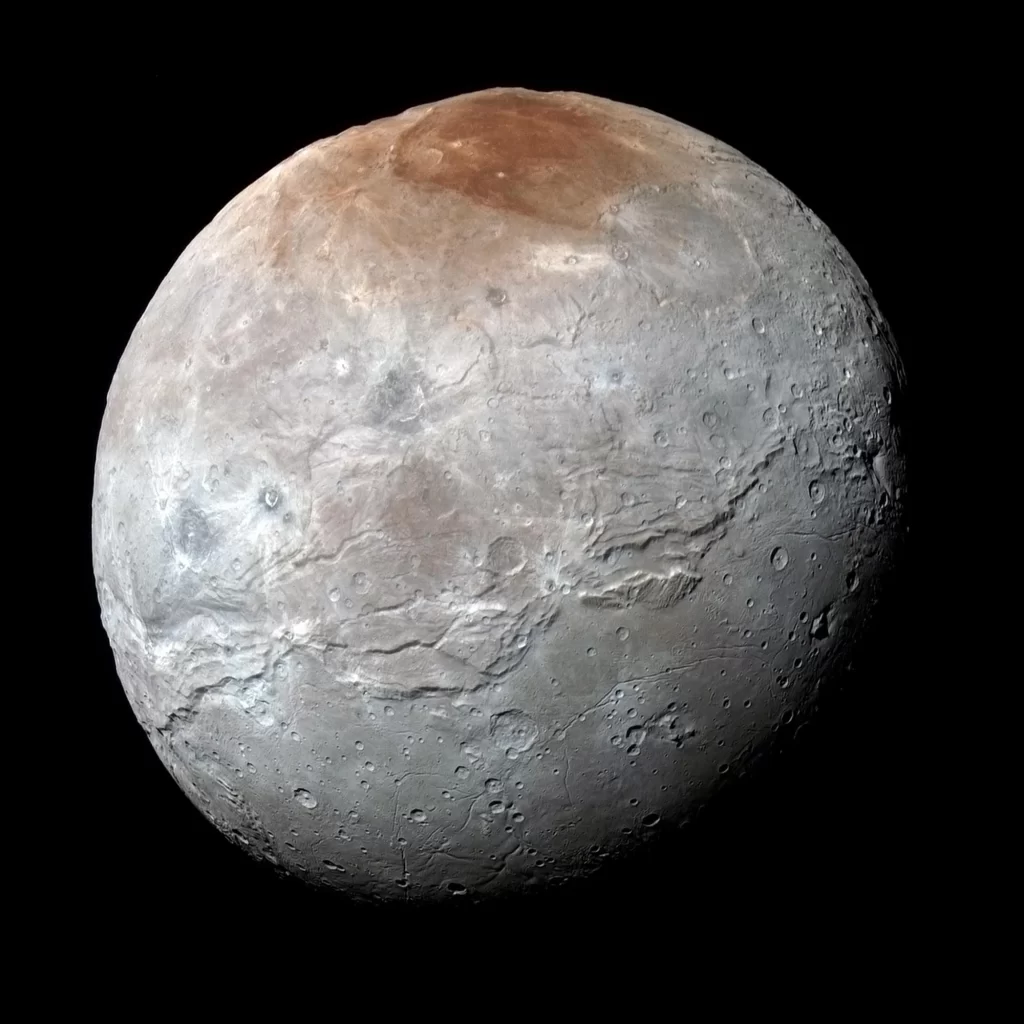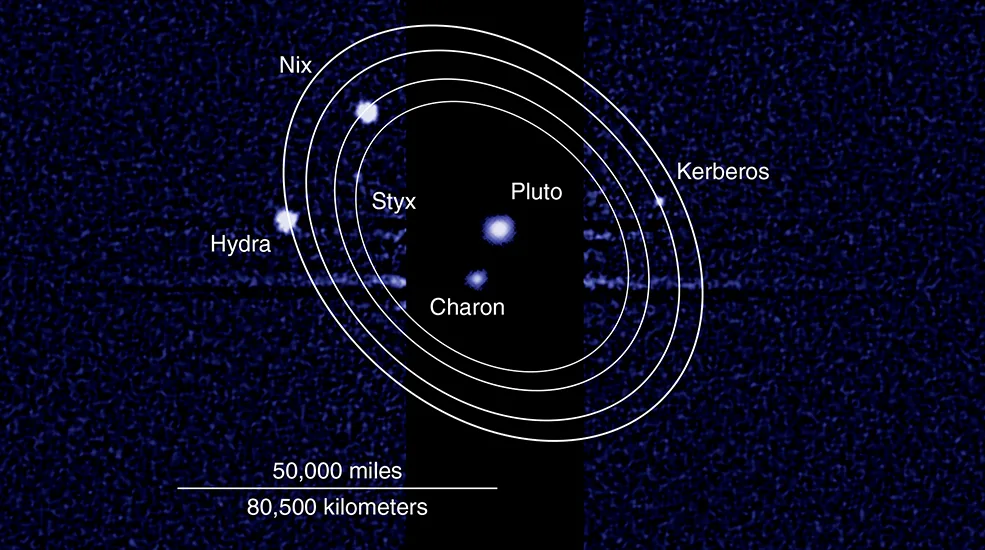Last updated on January 12th, 2024
Pluto is a dwarf and not a full-sized planet. Plutonium, a transuranic radioactive element, was named after Pluto. Prior to its naming, Uranium was named after Uranus, and Neptunium after Neptune. Pluto, like Venus and Neptune, rotates backward, i.e from east to west. The planet also rotates on its side. Pluto takes 248 Earth years to revolve around the Sun. This is the longest orbit time among other planets. With these facts about Pluto (the first Kuiper Belt object to be discovered) let us learn more about it.
Discovery
1. Pluto was discovered in 1930 by Clyde Tombaugh.
Location
2. Data from the Pioneer 10 and 11 spacecraft, which conducted flybys of Jupiter and Saturn, respectively, were used to refine calculations for Pluto’s position and size, aiding in its subsequent discovery by Clyde Tombaugh.

Naming!
3. Pluto is named after the Greek god of the underworld.
4. Pluto is the only planet named by an 11-year-old English girl — Venetia Burney, from Oxford. It was named so in 1930. The girl was awarded 5 pounds as a reward for suggesting the name. Her grandfather passed on the suggestion to a friend at the Lowell Observatory, and the name was accepted.
How big?
5. Pluto is smaller than the Earth’s moon and is half as wide as the United States.
Beyond Pluto
6. In 2003, a new object beyond Pluto was discovered by an astronomer — Michael Brown. After the discovery of this new object – Eris – astronomers pondered upon the characteristics that make an object in the sky “a planet”. And they came to a conclusion that Pluto shall be classified as a Dwarf planet henceforth.
Reclassification
7. Pluto was reclassified as a Dwarf planet in 2006 by the International Astronomical Union. It is called a dwarf planet because of its small size and lack of enough capability to clear debris and object out of its path around the sun.
Called an asteroid
8. On September 7, 2006, Pluto was assigned the asteroid number 134340 by the Minor Planet Center.
Pluto’s gravity
9. If one weighed 100 pounds on Earth, they would weigh only 7 pounds on Pluto – that’s how weak the planet’s gravity is, as compared to that of the Earth.
10. Due to its low gravity, Pluto’s atmosphere extends much higher into space compared to Earth’s. Pluto’s gravity is only about 1/15th of Earth’s gravity, making it difficult for the planet to retain a thick atmosphere.
Pluto vs Earth’s Moon
11. Pluto is 2/3rd the diameter of Earth’s moon and its mass is 1/6th the mass of Earth’s moon.
Day’s length
12. One day on Pluto is also 6.4 Earth days.

Length of the day on the planets
| Planet | Length of Day |
|---|---|
| Mercury | 1408 hours |
| Venus | 5832 hours |
| Earth | 24 hours |
| Mars | 25 hours |
| Jupiter | 10 hours |
| Saturn | 11 hours |
| Uranus | 17 hours |
| Neptune | 16 hours |
Distance from the Sun
13. Pluto can be as far as 49.3 AU from the Sun in its elliptical orbit where it takes 248 years to complete a revolution around the Sun.
Sunlight
14. Due to the enormous distance between Pluto and the Sun, the sunlight takes almost 5 hours to reach Pluto. And it (sunlight) takes 8 minutes and 20 seconds to reach Earth.
The intensity of the Sun
15. During the daytime, the Sun would be 1/900 times dimmer on Pluto than full daylight on Earth.
Missions to Pluto
16. There has been only one mission to Pluto until now. Pluto remained unexplored by space crafts until NASA’s New Horizons mission conducted a historic flyby in July 2015, providing the first close-up images and data. New Horizons is about the size of a piano and is also the first spacecraft to flyby Pluto.
17. To conserve power during its long journey to Pluto, the New Horizons spacecraft entered a sleep mode for periods of time, waking up periodically to check systems.
18. It takes about 4.5 hours for radio signals to reach New Horizons near Pluto and a similar time for data to be transmitted back, highlighting the vast distances involved.
19. New Horizons from NASA became the first spaceship to visit this dwarf planet- Pluto in July 2015. The New Horizons spacecraft discovered a large heart-shaped feature on Pluto’s surface, officially named “Tombaugh Regio” after Pluto’s discoverer, Clyde Tombaugh. It is a large, light-colored regio about 1,590 km (990 mi) across.
Fulfilling discoverer’s wish
20. A small container with a portion of Clyde Tombaugh’s ashes was aboard the New Horizons spacecraft; fulfilling his wish to be part of the exploration of the distant worlds he spent his life studying.
Big dents on the planet’s surface
21. Craters as large as 260 km in diameter have been seen on Pluto.
22. Dark spots on Pluto’s surface, including a whale-shaped feature, have caught scientists’ attention. The exact nature of these dark spots and their formation mechanisms are still under investigation.
23. The origin of Pluto’s “snakeskin” terrain, characterized by a pattern resembling snakeskin, is not yet fully understood. It may be related to convection processes or other geological activities.
24. Pluto has vast plains covered in nitrogen ice that form glaciers resembling the flowing glaciers of Earth. These are found in the Sputnik Planitia region. It is approximately 1,000 kilometers across and is almost directly opposite the side of Pluto that always faces Charon as a result of tidal locking.

25. Some of Pluto’s mountains are believed to be made of methane ice. This makes them unique geological formations in the solar system. The planet, thanks to the combo of thin atmosphere and low temps means that methane can exist in a liquid state and potentially rain down onto the surface.
26. In addition to nitrogen and methane, Pluto’s surface is covered in various ices, including carbon monoxide, ethane, and tholins, contributing to its diverse and complex composition.
Rocky core
27. It is suspected by the scientists that Pluto has a rocky core which is surrounded by a mantle of water ice.
Water or ice?
28. Pluto has a lot of water in the form of ice. The amount of this water contained on the planet is almost thrice the amount reserved in all the Earth’s oceans.
Elements on Pluto
29. Scientists have estimated that water might be in existence between the rocky core of Pluto and its thick outer layer of ice. It is also believed that the planet’s water should also be containing biogenic elements like carbon, hydrogen, calcium, nitrogen, potassium, phosphorus, magnesium, sulfur, chlorine, sodium, and iron.
Absence of Oxygen
30. No traces of oxygen have been detected on Pluto yet.
Life?
31. As per the data gathered from Pluto, scientists believe that the existence of life is not possible on the planet.
Far, far, far away
32. The distance between Pluto and the Sun is 40 times the distance between the Earth and the Sun.
Kuiper Belt
33. The orbit of Pluto lies in the Kuiper Belt. There are many other small icy worlds in this region, which are also known as ‘transneptunian objects’ or ‘Kuiper Belt objects.’
Neighbours
34. Pluto has a 2:3 orbital resonance with Neptune, meaning it completes two orbits around the Sun in the time it takes Neptune to complete three. This ensures that the two never come into close proximity.
Elliptical orbit
35. Pluto has an elliptical orbit and hence when it is closest to the Sun, its ice changes to gaseous form and forms a thin atmosphere over the planet. Pluto’s orbit is inclined at an angle of about 17 degrees relative to the plane of the solar system, contributing to its distinctive orbital characteristics. Charon, the largest moon of Pluto, takes around 6.4 Earth days to complete a revolution around the planet.

Its moons
36. Pluto has five moons – Charon, Nix, Hydra, Kerberos, and Styx.
37. Unlike many moons in the solar system that exhibit orbital resonances (specific ratios of orbital periods), Pluto’s moons do not demonstrate stable resonant relationships. This lack of resonance adds to the dynamic and puzzling nature of Pluto’s moon system.
38. Despite its small size, Pluto has a relatively large moon, Charon, which is about half the size of Pluto itself. Hence, Charon is the largest known satellite relative to its parent body.
39. Pluto’s largest moon, Charon, was named in 1978 after the mythological ferryman who transported souls across the river Styx to the underworld. The name was fitting, given Pluto’s association with the god of the underworld. Charon, was discovered by James Christy in 1978 at the United States Naval Observatory. Its existence helped refine calculations of Pluto’s mass.
40. While Pluto and Charon are tidally locked to each other, meaning the same sides always face each other, they do not always present the same face due to their mutual orbital eccentricities.
41. Pluto has a chaotic rotation, meaning its axis of rotation undergoes unpredictable changes over long periods, influenced by gravitational interactions with its moons.
42. Inspired by Pluto’s distance from the Sun and its dim sunlight, the concept of “Pluto Time” was introduced. It refers to the time of day when the lighting conditions on Earth resemble those on Pluto.
43. If you were standing on Pluto, you would experience sunsets where the Sun appears as only a bright point of light, given the dwarf planet’s distance from the Sun and the scattering of sunlight in its thin atmosphere.
44. Pluto’s moons, Nix and Hydra, were named in 2006 after characters associated with the mythological underworld, continuing the theme established with Charon.
45. Pluto’s moons, particularly Nix and Hydra, are known for their rapid rotation. Nix, for example, completes a full rotation every 43 seconds.
. . . continue reading facts about Pluto on the next page
